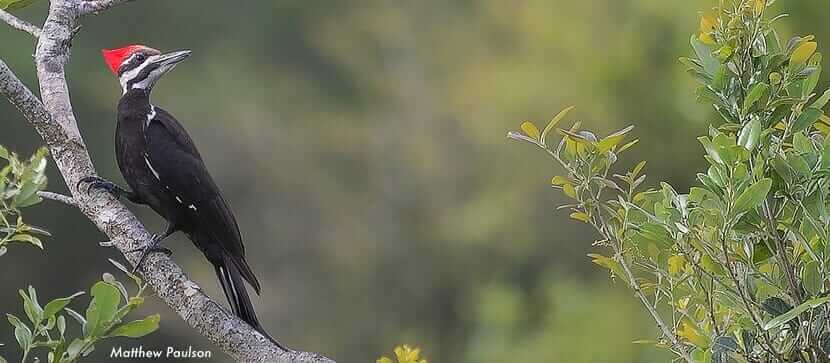How the Woodpecker Got His Colors
by Johnny Palka, Whidbey Institute Senior Fellow
One afternoon in early July I was walking on the Chinook land, the beautiful protected forest of the Whidbey Institute. Partway up a low ridge I heard a sharp, resonant rap, then a few seconds later another. When I looked around for the source, I spotted a magnificent Pileated Woodpecker clinging to the side of a Douglas Fir trunk, and excavating his signature rectangular cavity in search of insects. Of course, I wanted to take his picture, but my telephoto lens was buried in my backpack. So I stopped, slowly took off the backpack, unloaded it to the get to the long lens, removed the short lens from my camera, replaced it with the telephoto, stood back up, and looked again toward the Pileated. There he still was, unperturbed, continuing to excavate the same cavity. He allowed me to take several photos (see sidebar), then circled sideways around the trunk to start another excavation on the back side where I could no longer see him, only hear his chiseling beak hard at work.
Intimate encounters like this always seem to leave me with two feelings. One is a feeling of connectedness with the creatures or objects I have observed, and often also of gratitude that I have had the privilege of experiencing this connection. The other is a feeling of curiosity and wonder at the deepest nature of what I am experiencing. In the case of the woodpecker, I felt privileged to have been in his presence for so long, and seemingly without his having felt disturbed, AND I felt very curious about what makes black feathers black, white feathers white, and red feathers red to my personal experience.
The link between the woodpecker’s feathers and my own internal experience is best understood by contemplating the physical nature of light, including its quantum aspects. That is the direction that my mind most wants to go! I will be exploring this topic, and others that are at the interface between personal experience and how nature works, in many subsequent pieces.

